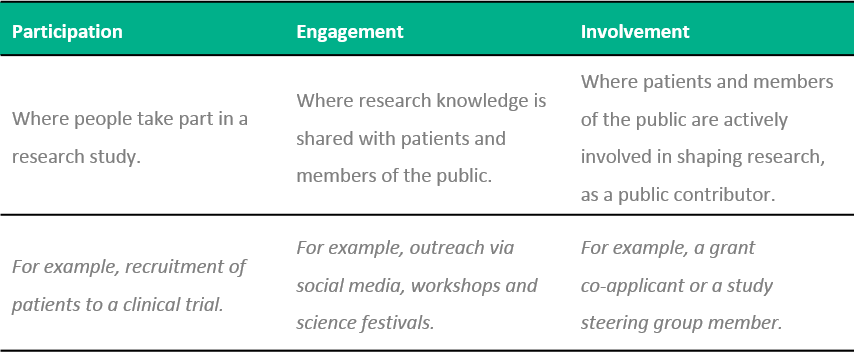Making research everyone’s business
The expertise of patients and carers is increasingly recognised as an essential component of research and no longer considered just a "nice to have".
Not that long ago, research was viewed as scary scientists in white coats, injecting solutions into the arms of restrained victims, turning them into Frankenstein. Okay, that’s never really been the case, yet research remains a poorly understood area of healthcare amongst many individuals and groups around the world.
Giving research the importance it deserves
Since the National Institute for Health Research (NIHR) was established in 2006, research really has been placed on the health and social care agenda in the United Kingdom (UK).1 Between 2014 and 2015, more than 260,000 people took part in NIHR research studies, helping to understand new ways of preventing, identifying and treating ill health.2 Although the NIHR has transformed research in the National Health Service (NHS), there’s still a long way to go.
Historically, research was left to the researchers – the experts. Patients were just people who received the treatment or intervention from the professionals, quietly and without question. That’s not the case anymore. The expertise of patients and carers is increasingly recognised as an essential component of research – making it more relevant and cost-effective in the long-term.4
As a patient, it is easy to underestimate the expertise that you have. From treatments, to understanding your disease, and the impact on your quality of life – you have a lot to give.
I first became involved with research in 2012, after attending an open evening for young people with musculoskeletal diseases. There, I met my former paediatric rheumatology consultant, who informed me about a vacancy for a patient representative on the NIHR Clinical Research Network (CRN): Children/Arthritis Research UK Paediatric Rheumatology Clinical Studies Group. It was all a little bit overwhelming as I didn’t really know what it entailed. Although I understood the fundamentals of medicine research and development, I didn’t fully appreciate the complexity and breadth of research. During my first face-to-face meeting on this group, I was sat amongst twenty health professionals and thought ‘How on earth can I contribute the level of expertise that these other people do?’ Four years later, with a vast amount of experience and involvement as a patient representative, my views have completely changed. I’ve grown in confidence to speak about matters important to patients and their families, as well as having a great understanding of research and healthcare in general. However, what hasn’t changed is my personal, lived experience of living with ill health. As a patient, it is easy to underestimate the expertise that you have. From treatments, to understanding your disease, and the impact on your quality of life – you have a lot to give. Although health professionals and researchers are incredibly skilled, unless they’ve lived with certain health problems, it’s impossible for them to fully understand the impact of ill health on your life and that of your family and friends.
Involving the real experts: patients
Since the NIHR was established, there has been an increasing awareness of the positive contribution that patients and the public can make to healthcare research.5 At national and international levels, there are a growing number of individuals and organisations supporting patient and public involvement in healthcare research6-9, encouraging widespread adoption of an integrated model of research between researchers and the public.10-13 Recently, the framework for public involvement in research has been restructured4, to better address the importance of person-centric health research. Historically, the terms consultation, collaboration and user-controlled were used to describe different levels of patient and public involvement in research. However, these have evolved to encompass participation, engagement and involvement in research, representing three different stages of association and commitment, to best meet the needs of individuals contributing to research (Table 1).14

Historically, research was viewed as an add-on people only considered when existing treatments had failed. Personally, I envisage research shifting to an integral aspect of modern healthcare delivery, as are consultations and treatment. Whether that be taking part in a clinical trial, completing a questionnaire, becoming a patient research ambassador or being an adviser on a research project. Getting involved in research can help you to learn more about your condition and ways to manage it. It can also boost your confidence – an easy target when you are learning to live with ill health. Research can also help you to have a voice – helping to influence the care you and others may receive in the future.
Patient involvement is more than a “nice to have”
The NIHR stipulates that patients and the public must be involved in all aspects of research, from prioritisation exercises, to designing, conducting, evaluating and disseminating research.5,15 Health and social care research that does not involve patients and the public is now considered flawed. Patient and public involvement should begin at the earliest opportunity. Preferably, any research should be based upon six core values, which integrated teams of researchers and the public must strive to achieve. These are respect, support, transparency, responsiveness, diversity and accountability.16 Ultimately, people who are directly, or indirectly affected by research have a right to say what publicly funded research is undertaken, and the way in which it is conducted. Regardless of profession or experience, individuals designing, engaging and participating in research are contributing to a ‘research active’ nation.16 Researchers must not assume that what they want is what patients want. Researchers, patients and the public have expertise in their own rights, and when such experiences are shared, they can influence research for the better.
Research has helped me to develop a greater appreciation for how we best care for people with ill health. My involvement as a patient representative has evolved to the point where I wanted to pursue a career in research. I am now a PhD student at the University of Leeds, looking at self-management of complex health conditions in children. Despite being at this early stage in my career, I am still a patient. Several people question whether I am a ‘real patient’ now that I am a researcher – something which I certainly take with a pinch of salt. I am still as much a patient as I was before I started my PhD. If anything, I am now more confident in my understanding of my conditions, and I can better articulate the impact and consequences of my health conditions on my daily life.
The NIHR have published their strategic goals, which includes a dashboard of performance indicators to evaluate public participation, engagement and involvement in research.17 Transparency in research practice has been shown to empower people who use health and social care services, providing a route of influencing change and improving issues which concern people the most. The NIHR’s Patient Research Ambassador Initiative and Join Dementia Research Initiative18-19 are two clear examples of how patients and the public are influencing change for the better, whereby patients, members of the public and researchers are at the heart of research, as equal partners. I am proud to be have been involved with the Patient Research Ambassador Initiative, promoting the patient voice, trying to get more people engaged and involved in research. By talking more about research, and helping researchers to better involve patients and families, we can ensure that research is everyone’s business, and high on the agenda in society.

Simon is a service-user researcher, having recently graduated from The University of Manchester with a BSc (Hons) in Biomedical Sciences. He is now embarking on a PhD at the University of Leeds, in the field of child health. His research interests include self-management of complex long-term conditions, having learned first-hand what it is like to live with ill health from a young age. Simon was diagnosed with a form of childhood-onset arthritis at the age of three, and has since been diagnosed with fibromyalgia and inflammatory bowel disease. Inspired by his own experiences, Simon is now a health activist, acting as a consumer health advocate and patient research ambassador for people living with long-term conditions, in collaboration with a variety of organisations around the world.
Links:
http://simonstones.wordpress.com
https://uk.linkedin.com/in/simonstones
Sources:
- NIHR. (2016). About the NIHR. Available from: http://www.nihr.ac.uk/about/
- NIHR. (2016). NIHR at 10. Available from: http://www.nihr.ac.uk/about/nihr-at-10.htm
- Office for National Statistics. (2016). Population estimates. Available from: https://www.ons.gov.uk/peoplepopulationandcommunity/populationandmigration/populationestimates
- INVOLVE. (2012). Briefing notes for researchers: public involvement in NHS, public health and social care research. NIHR. Available from: http://www.invo.org.uk/wp-content/uploads/2014/11/9938_INVOLVE_Briefing_Notes_WEB.pdf
- NIHR. (2015). Going the extra mile: improving the nation’s health and wellbeing through public involvement in research. Available from: http://www.nihr.ac.uk/documents/about-NIHR/NIHR-Publications/Extra%20Mile2.pdf
- Arthritis Research UK. (2010). The role of stakeholder representation in research funding: experiences from Arthritis Research UK’s stakeholder panel, ‘USER’. Available from: http://www.twocanassociates.co.uk/perch/resources/files/stakeholdersinresearch(1).pdf
- NHS England. (2013). The NHS belong to the people: a call to action. Available from: https://www.england.nhs.uk/wp-content/uploads/2013/07/nhs_belongs.pdf
- NHS England. (2013). Transforming participation in health and care: ‘the NHS belongs to us all’. Available from: https://www.england.nhs.uk/wp-content/uploads/2013/09/trans-part-hc-guid1.pdf
- Preston, J., Stones, S. R., Barker, L. & George, E. Exciting things happen when involving young people to promote better research for better healthcare, in DPharm Europe. 2016. London, United Kingdom. Available from: http://generationr.org.uk/wp-content/uploads/2016/02/GenRDPharmwithoutvideos.pptx
- Lewenstein, B. V. (1995). From fax to facts: communication in the cold fusion saga. Social Studies of Science 25: 403-436.
- Schiele, B., Claessens, M. & Shi, S. (2012). Science communication in the world: practices, theories and trends. The Netherlands: Springer.
- Bultitude, K. (2011). The why and how of science communication, in Rosulek, P. (ed). Science Communication. European Commission: Pilsen.
- Tlili, A. & Dawson, E. (2010). Mediating science and society in the EU and UK: from information-transmission to deliberative democracy? Minerva 48(4): 429-461.
- NIHR. (2014). Patient and public involvement in health and social care research: a handbook for researchers. Available from: https://www.rds-yh.nihr.ac.uk/wp-content/uploads/2015/01/RDS_PPI-Handbook_2014-v8-FINAL-11.pdf
- Stones, S. R., Majeed-Ariss, R. & Swallow, V. M. Patients and academics as co-researchers: dream or reality, in Leeds Children’s Hospital Conference. 2015. Leeds, United Kingdom.
- INVOLVE. (2014). Policy on payment of fees and expenses for members of the public actively involved with INVOLVE. NIHR. Available from: http://www.invo.org.uk/wp-content/uploads/2014/11/INVOLVE-internal-payment-policy-FINAL-August2014.pdf
- NIHR. (2014). Promoting a ‘research active’ nation. Available from: http://www.nihr.ac.uk/documents/get-involved/Promoting%20A%20Research%20Active%20Nation_NIHR%20Strategic%20Plan_May%202014.pdf
- NIHR. (2016). Patient Research Ambassador Initiative. Available from: https://sites.google.com/a/nihr.ac.uk/patient-research-ambassador-initiative/
- NIHR. (2016). Join Dementia Research. Available from: https://www.joindementiaresearch.nihr.ac.uk




Comments